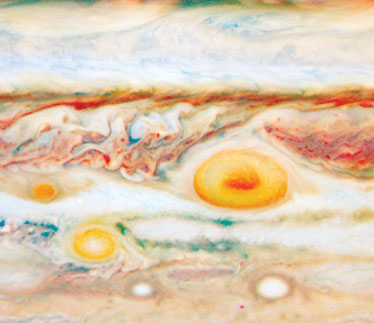A CASE OF PLANETARY MEASLES NASA/ESA/UC BERKELEY
What appears to be a painterly study -- of egg yolks? perhaps a dreamscape? -- is actually an image of Jupiter gleaned by the Hubble Space Telescope. Astronomers, including ones using the Keck II telescope on Mauna Kea, see a growing number of red spots: besides the big one, hundreds of years old, another (at bottom) started developing eight years ago, and a third (at left) popped up just months ago.
|
|
By Jove! Big Isle scope sees planet’s ‘measles’
A new red spot has appeared on Jupiter, stunning the world's stargazing community
HILO » Jupiter is developing an astronomical case of giant red measles. And it could be a symptom of climate change on the largest planet in the solar system.
The discovery this month of a third red spot on Jupiter prompted the Hubble Space Telescope people to call the appearance "a case of planetary measles."
Images of the group of red spots were made May 9-10 using the Hubble telescope. Follow-up images were made on May 11 using the Keck II telescope on Mauna Kea.
The discoveries are creating a hubbub in the astronomical world.
Astronomer Imke de Pater at the University of California at Berkeley, one of the scientists who took the pictures, called the changes on Jupiter a "major upheaval."
The largest red spot has been known for centuries, a discovery often attributed to English astronomer Robert Hooke in 1664.
This spot, three times as wide as Earth, is a bulge poking up five miles higher than surrounding cloud layers, a Keck statement said.
Astronomers started seeing large white spots near the Great Red Spot beginning in 1939. In 2000 some of the white spots combined to form "Oval BA." In 2005 the oval turned red, leading to the nickname Red Spot Jr.
Until recently, Jupiter was on the other side of the sun from Earth, but when it came into view again, it was sporting yet another red spot near the first two.
The cause of the red color is unknown. "Why the spots are red is the subject of great debate," the Keck statement said.
Also unknown is the reason for a lot of atmospheric turbulence in the area, first noticed by the Voyager spacecraft in 1979 west of the Great Red Spot and continuing to the present. The latest images show turbulence on both sides of the red spot, de Pater said.
In 2004, Berkeley professor of fluid dynamics Philip S. Marcus theorized that Jupiter is in the midst of global climate change that could result in temperatures up to 18 degrees Fahrenheit warmer at the planet's equator but colder at its south pole.
He predicted the changes would be seen in new whirlpools of gases.
"Whether or not Jupiter's climate has changed due to a predicted warming, the cloud activity over the last 2 1/2 years shows dramatically that something unusual has happened," Marcus said.
And more drama is likely, according to astronomer Michael Wong, who works with de Pater.
"If this (new) spot and the Great Red Spot continue on their courses, they will encounter each other in August, and the small oval will either be absorbed or repelled by the Great Red Spot," he said.

